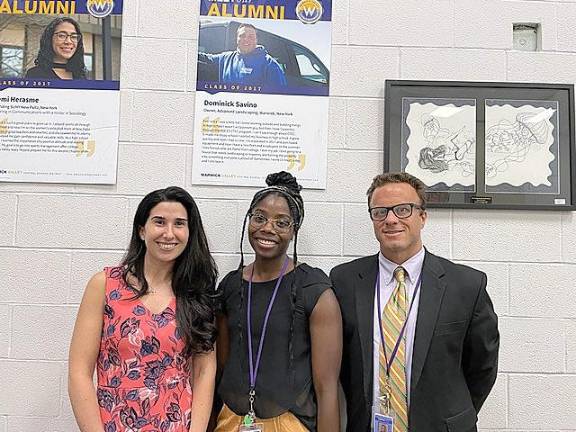Warwick schools superintendent sees “challenge at all levels”
Warwick. Cops in buildings, substance abuse prevention and peer intervention are among strategies Superintendent David Leach said will be used to make Warwick Valley schools a safe place for learning.

Citing the ongoing emotional challenges of the COVID -19 pandemic and the need to keep students away from drug and alcohol use and abuse, Warwick Valley Schools Superintendent Dr. David Leach said that it’s “a challenge at all levels” at last Thursday’s regular monthly board meeting.
Leach presented the strategies the district will use to address these issues.
As the district’s plans focus on both mental health issues and school safety, their partnership with Warwick Valley Prevention Coalition will continue. Long-time school board member Bob Howe continues as liaison to the Coalition.
Substance use/abuse undermines learning, safety
In his presentation, Leach cited the results of a district survey. Kids were asked about their use of substances in the 30 days prior: Among students in grade 8, 6 percent reported that they had used drugs/cigarettes/alcohol; 10 percent of 10th graders asked the same question responded likewise; 23 percent of 12th graders answered that they, too, had used some or all of these substances in the previous 30 days.
As part of its safety protocol, WV has 4 full-time Warwick police officers, 5 School Resource Officers (SROs), and 14 security guards on staff. There is also a junior police academy, and the district is looking at reviving the DARE program.
The district is using these resources – as well as offering extracurriculars – as a way of involving kids in positive activities.
WV schools also offers teacher training and in-school support, through health classes at the middle school and high school, tackling the issue of peer pressure and the harm of substance abuse.
Breathalyzers are also used at high school dances, Leach added.
The middle school and high school have their own respective chapters of the prevention coalition, and work with the larger WV Prevention Coalition, who offer programs like the community marijuana forum, and “Hidden Mischief:” the latter being a mock-up of a teen bedroom that allows parents to search for signs of substance abuse and/or self-harm.
To address underage drinking, the district works with ADAC and Stop DWI and participates in Red Ribbon Week, “America’s largest and long-running annual drug use prevention campaign.”
SADD (Students Against Destructive Decisions) has active chapters at both the middle school and high school. Elements include the Contract for Life, which enables parents to extricate students from unsafe situations, no questions asked, and a 90-minute teen driver awareness forum that students must attend to receive parking privileges at the high school (the course will be offered again later this month, Leach said).
New security measures
Final stages of “every door in the district...will notify us electronically if a door is left ajar,” Leach said. He added that license plate reading cameras are now on campus, and that an active shooter drill in November will include staff training, though “a strong plan” is in place, he said
Coming in 2022-23
Leach said that anti-bullying groups Mallory’s Army and Sweethearts and Heroes will help kids with emotional support and making good choices.
Mallory’s Army is named for a girl who committed suicide after being bullied on social media; the district will hold an event at the high school for parents and students with the group.
Sweethearts and Heroes will offer an event at the middle school with role models such as a former Marine.
Other measures
Both the high school and middle school have Codes of Conduct to address substance abuse and awareness.
Teen Intervene gives principals the discretion to offer intervention to students found to be using substances on school grounds: It’s “not all about punishment,” Leach said. Still, he added that a WPD K-9 presence will be in the school district.
The emotional quotient
Leach talked about the three-tier system in place, that includes social/emotional learning, which teaches all students how to regulate their feelings, and where to go for help when they need it, and involves both teachers and counselors to help support students emotionally when necessary. A clinical component is also available for students and their families, when students need more complex support.
Students are taught how to regulate their feelings, to encourage appropriate responses to challenging situations, part of enabling them to make healthy choices in life. Programs that encourage students’ sense of belonging – like Spirit Days and Homecoming – are part of this.
Leach said that he wants middle and high school parents to encourage elementary grade parents to attend these programs, “Not to scare them,” but to prepare them for what their kids are likely to encounter in the upper grades.
New faces in the district
The board welcomed three new hires to the district: Alexandra D’Angelo, Director of Special Education; Erin Hill-Lewis, and Chris Fiorentino, two new secondary associate principals at the high school. Both Hill-Lewis and Fiorentino have extensive math backgrounds, in addition to their other skills.
“I look forward to working with the community,” D’Angelo said, and thanked the board for the opportunity.
Hill-Lewis, a former NYC math teacher said, “I’m excited to bring what I’ve learned to this job.”
“I’m very student-centered,” Fiorentino said, and added that he is “excited for September 6 to come.”
Teen Intervene gives principals the discretion to offer intervention to students found to be using substances on school grounds: It’s “not all about punishment,” Leach said. Still, he added that a WPD K-9 presence will be in the school district.